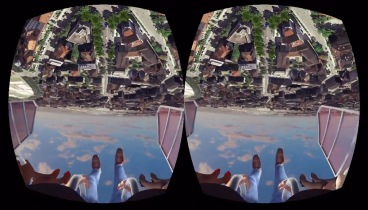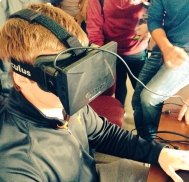On Christmas Day, family members from their teens to their 80’s filled the holiday kitchen to get a look at this wild, futuristic technology: the Oculus Rift DK1, brought by my older cousin; a software developer. It was my turn up to bat after watching my cousins stumble around and come out completely astounded by Cyber Space: still the most intense VR game that I’ve played to date. The premise is similar to the King’s Island swinging pirate ship ride, but it goes all the way around; terrifying stuff.
Slipping the black hood over my eyes, I became immersed in the virtual world. Before I knew it, the lap bar locked me to my seat and lurched forward.The thing is, I hate roller coasters. And when  you’re wearing the Oculus, all that you can see is the virtual landscape in 360 degrees. There’s no looking away or escaping it. So this was about to be a wild ride.
you’re wearing the Oculus, all that you can see is the virtual landscape in 360 degrees. There’s no looking away or escaping it. So this was about to be a wild ride.
Swing after swing, the centrifugal force on the virtual seat never let up, and a feature that made the demo even more ridiculous is the ejection. By pressing the enter key at any time, your body gets launched from the safety of the seat, and plummets toward the ground of the cityscape, so of course I got flung. Thanks for that one developers! It was all a simulation but I was shocked at how real it felt, so shocked that I screamed and yelled the whole time, and of course my family got it on video.
I was a little freaked out, but not like this guy freaked out:
Honestly though, I loved every second of it. Staying up to speed with the cutting edge of technology is a huge passion of mine, so when my cousin offered that I could borrow the Oculus for a while, I was pumped!
How it works:
The Oculus Rift DK1 can look like a confusing mess of wires and cables when connected, but the virtual magic isn’t beyond explaining by any means.
- Stereoscopic 3D: Two slightly different images are displayed to the Oculus, where each is fused into one single image through the lenses of the headset. Similar to 3D movies, this gives you that feeling of depth and realism in-game.
- Positional tracking: Take a look around, and the Oculus follows. By translating the in-game image 360 degrees around you, and the Oculus knowing where you are inside the virtual world, the sense of motion adds so much to the level of immersion that you feel.
After downloading pretty much every game I could find, and getting pretty motion sick in the process, I was learning a ton and was thoroughly blown away by virtual reality. I had just about every game imaginable; racing, horror, flight simulation, even Breakfest: a game where you had to play Flappy Bird while simultaneously eat a bowl of cereal. So, of course I brought it back with me to college.
I’ve gotten several dozen people to check out the Oculus now, and I obviously use the Cyber Coaster as my go-to demo, because it rocks. From friends to prospective students doing an overnight visit, the VR headset has gotten plenty of use, one might say that it increased the school’s enrollment for the 2015 year, who’s to tell. But the culmination of my use of the Oculus Rift was applying it to a group project in a humanities course– not science in the halls of BSC, but in Haupt’s Intro to Philosophy. It was time to get this mind-blowing tech into the halls of college academia.

I took brave volunteers.
Don’t Let Go – A Virtual Reality Experience
You find yourself sitting in front of a desk, how you got there? Who knows. A face pops up on the laptop sitting on the surface in front of you, giving you some quick directions, and then you’re on your own. The task is to not let go of the CTRL keys on the laptop, as a number of scenarios and environmental factors test your willpower. You can get scared, but don’t let go. What happens if you do lift your hands off of those keys, though?
If you let go, something bad will occur. In this case, letting go will cause something bad to happen to a loved one, so it is up to you to endure whatever happens to you in the simulation. People are opt to break their morals when issued a challenge, and that’s exactly what is facing you in this situation.
So what do you do? It is entirely up to you.
Showing off the Oculus in the classroom setting was a lot of fun, and made for an interesting, cross-disciplinary presentation. I continue to let anyone who wants to experience VR get their share, and now that Unreal Engine 4 is free to use, my prospects of playing around with the Oculus from the software development side are increasing. My plan would be to make some kind of simulation that tests your on-the-fly moral decision-making skills, because we’re lacking that and I feel it would provide some great philosophical insight.
Explaining a scenario like the Trolley Experiment gives you too much time to think about the situation, where a fully-immersed demo with the Oculus Rift would cause a person to make decisions from the Utilitarian or Kantian perspective immediately. This would display a truer sense of their morality devoid of social pressures to think a certain way; based on how they see the situation, not how society sees it.
This combination of technology, philosophy, and psychology is a great example of how a liberal arts class should be, and has been one of my favorite experiences at Transylvania. I am definitely going to keep playing with the Oculus, hopefully developing something, and learning even more from the potential invested in virtual reality.
